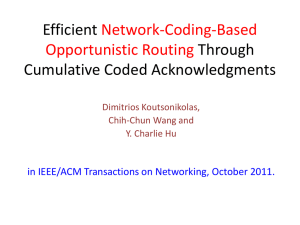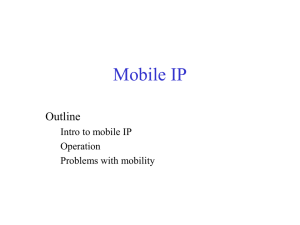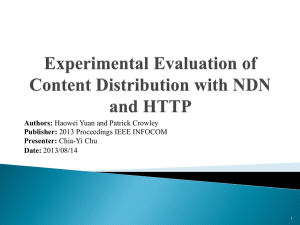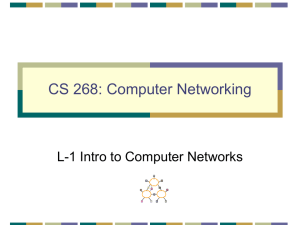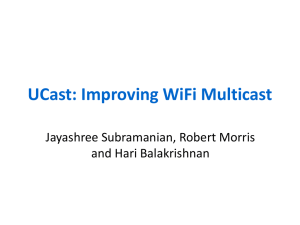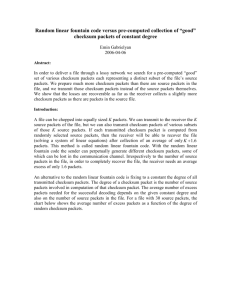MCA 2: Multi Core Architecture for Mitigating Complexity Attacks
advertisement
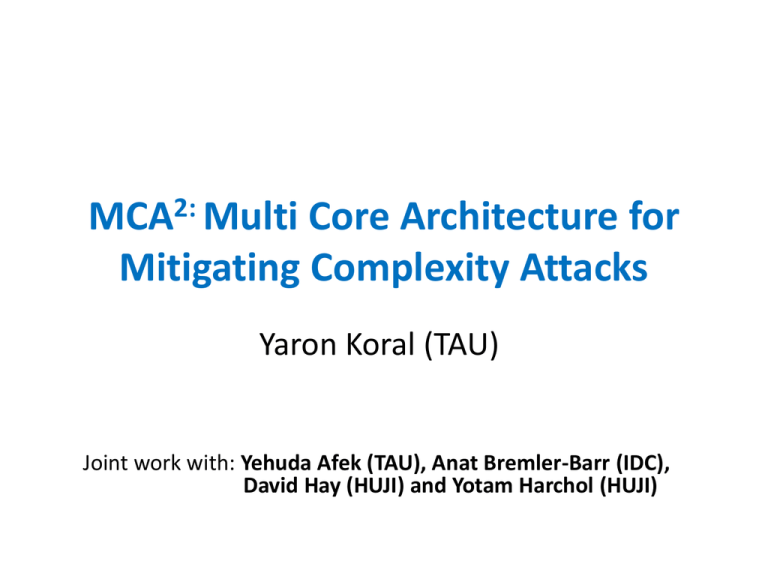
MCA2: Multi Core Architecture for Mitigating Complexity Attacks Yaron Koral (TAU) Joint work with: Yehuda Afek (TAU), Anat Bremler-Barr (IDC), David Hay (HUJI) and Yotam Harchol (HUJI) A multicore system architecture, which is robust against complexity DDoS attacks Network Intrusion Detection System • Reports or drops malicious packets • Important technique: Deep Packet Inspection (DPI) IP packet Internet 3 Complexity DoS Attack Over NIDS • Find a gap between average case and worst case • One may craft an input that exploits this gap • Launch a Denial of Service attack on the system Internet Throughput 4 Attack on Security Elements Combined Attack: DDoS on Security Element exposed the network – theft of customers’ information Attack on Snort • The most widely deployed IDS/IPS worldwide. Max Throughput Routine Traffic Heavy Packet Traffic Airline Desk Example Airline Desk Example A flight ticket Airline Desk Example Overweight!!! Can’t find passport!! Doesn’t like food!!! An isle seat near window!! Three carry handbags !!! Airline Desk Example Airline Desk Example Special training Domain Properties 1. Heavy &&Light Lightpackets. customers. packets 2. Easy detection of heavy customers. packets between queues is cheap. 3. Moving customers between queues is cheap. 4. Heavy customers packets have special more efficient processing have special more efficient processing method. Some packets are much “heavier” than others The Snort-attack experiment Snort uses Aho-Corasick DFA •DPI mechanism is a main bottleneck in Snort Heavy •Allows single step for each input symbol Fast & Huge Packet •Holds transition for each alphabet symbol Best for normal traffic Exposed to cache-miss attack Snort-Attack Experiment Normal Traffic Attack Scenario Cache Main Memory Max Throughput Routine Traffic Heavy Packet Traffic The General Case: Complexity Attacks DomainisProperties • Building the packet much cheaper than processing it. 1. Heavy & Light packets. 2. Easy detection of heavy packets 3. Moving packets between queues is cheap. 4. Heavy packets have special more efficient processing method. Detecting heavy packets is feasible How Do We Detect? • Normal and heavy packets differ from each other • May be classified quickly • Claim: the general case in complexity attacks!!! threshold Domain Properties 1. Heavy & Light packets. 2. Easy detection of heavy packets 3. Moving packets between queues is cheap. 4. Heavy packets have special more efficient processing method. System Architecture • Routine and alert mode • Drop mode • Dynamic thread allocation model • Non blocking queue synchronization • Move packets between cores with negligible overhead! Q Core #1 Q Core #2 Q Core #8 Q Dedicated Core #9 Q Dedicated Core #10 Processor Chip NIC Detects heavy packets B B Domain Properties 1. Heavy & Light packets. 2. Easy detection of heavy packets 3. Moving packets between queues is cheap. 4. Heavy packets have special more efficient processing method. Snort uses Aho-Corasick DFA Full Matrix vs. Compressed Domain Properties 1. Heavy & Light packets. 2. Easy detection of heavy packets 3. Moving packets between queues is cheap. 4. Heavy packets have special more efficient processing method. Experimental Results System Throughput Over Time Different Algorithms Goodput Concluding Remarks • A multi-core system architecture, which is robust against complexity DDoS attacks • In this talk we focused on specific NIDS and complexity attack • Additional results show how the system fits to other cases: – Hybrid-FA – Bro Lazy-FA • We believe this approach can be generalized (outside the scope of NIDS). Thank You!!





